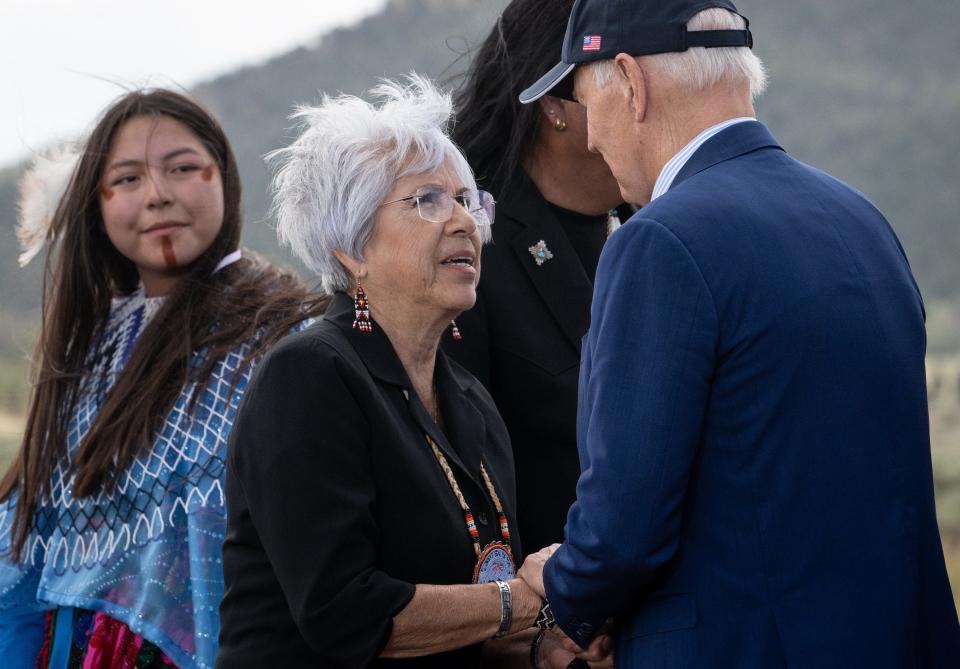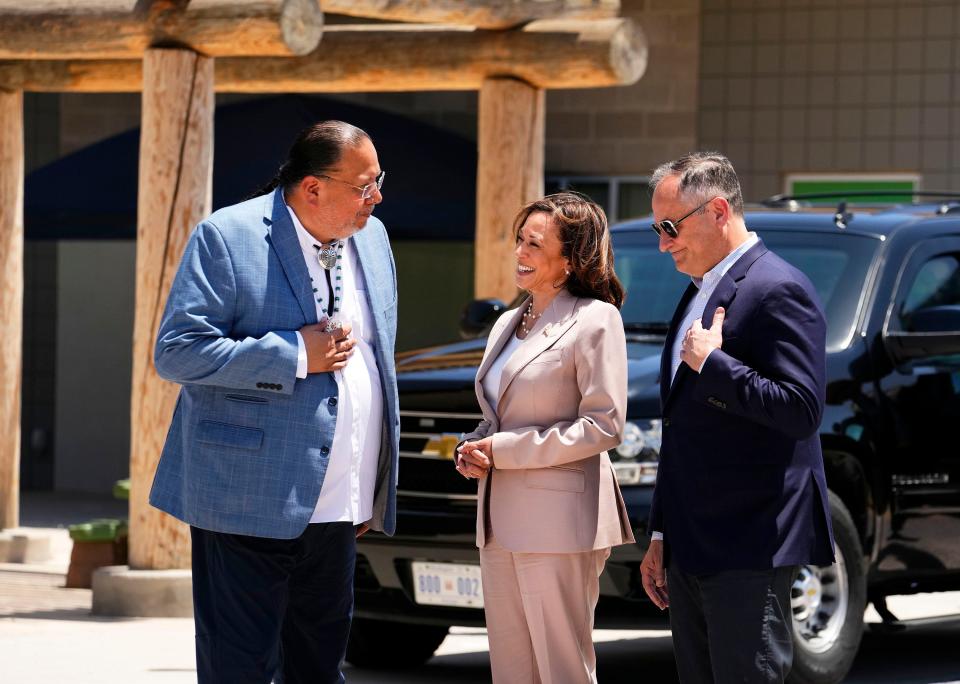These tribal leaders are water pioneers — and 2023 Arizonans of the Year
The Colorado River Indian Tribes and Gila River Indian Community began irrigating farmland thousands of years ago using water from the rivers that are now their namesake.
Water stewardship is an inextricable part of their community fabric and identity, and its leaders carry a deep obligation to care for what the Creator has provided.
The rest of us are relatively new to the water management debate, not the other way around.
“It’s in our blood — our DNA — to be caretakers of the land and water,” Gila River Gov. Stephen Roe Lewis said.
Lewis and Colorado River Indian Tribes Chairwoman Amelia Flores have become influential water caretakers in Arizona and across the Colorado River basin.
And their leadership comes at a crucial time for us all, as sustained drought and ever-increasing temperatures slash the amount of water flowing through the river on which 40 million people rely.
That makes them The Arizona Republic’s 2023 Arizonans of the Year.
Their vision and drive are paying off
Lewis and Flores were born and raised on their reservations — Lewis just south of metro Phoenix and Flores about 150 miles west of the city.
Lewis grew up with a front-row seat to history as his father, the late Rod Lewis, fought to secure the community’s water rights after upstream dams had decades earlier dried up many of its farms, leading to one of the nation’s largest water settlements.
Gila River secured more than 650,000 acre-feet of water a year — more than twice what the city of Phoenix delivers to taps. The tribe is entitled to more Central Arizona Project water than any other user.
Flores, meanwhile, spent nearly three decades as the tribes’ archivist, where elders mentored her on the community’s history and traditions, many of which revolve around water.
She was elected the community’s first chairwoman in 2020.
Her community holds one of Arizona’s largest and oldest Colorado River water allocations, laying claim to roughly 720,000 acre-feet of first-priority water.
Both have a clear vision for their communities and a relentless drive to achieve it.
Lewis speaks of his desire to create a cutting-edge “blue-green economy” that benefits its 21,000 members, while Flores sees her 4,000-member community playing a key role in “saving the Colorado River.”
Their vision and drive have paid off in spades this year.
Flores helped spur Congress to act

Flores helped push long-sought legislation over the finish line in January allowing the Colorado River Indian Tribes to lease some of their water to others in Arizona.
The measure is critical for the tribes, which plan to use the cash to improve their federally maintained irrigation system that loses nearly as much water as it delivers.
But it’s also a lifeline for cities and farmers, which desperately need water that is less likely to be cut as the river dwindles.
Congress authorized the deal, though state and federal agencies must still approve an agreement before any water can be leased.
Then, in April, Lewis stood with a who’s who of federal and state water officials announcing a $233 million deal to leave water in Lake Mead, fund a pipeline that would bring reclaimed water from Mesa to the community for irrigation and install solar panels over tribal canals.
Lewis said then — and many times since — that the tribe intended to lead by example, hoping that its efforts to conserve water would spur others to follow suit.
Lewis' leadership was lauded nationally

The deal was lauded nationally.
Not only for the good it could do on Lake Mead, but because a tribal leader was so prominently touting water stewardship.
Many noted that while tribes are entitled to about a quarter of the water on the Colorado, they had no say in the decisions that were made to manage the river a century ago — and little influence on the decades of agreements that followed, including the 2007 guidelines that now govern how shortages are doled out.
That is changing.
Lewis played a huge role in Arizona’s 2019 Drought Contingency Plan, which may not have shored up Lake Mead for long but fostered a willingness to compromise that the state so desperately needed.
We need tribes: At the water negotiating table
The feds are now more actively consulting with tribes on the rules that will govern how the lake operates in 2027 and beyond.
Congress also has earmarked billions for tribal water infrastructure, in an effort to finally turn what have long been just rights on paper into real, flowing water for communities.
They are becoming key regional voices
Lewis and Flores are active regional voices in water policy discussions, speaking at conferences and meeting behind-the-scenes with key players.
Lewis has spent a ton of time in Washington, D.C., talking to officials and testifying before Congress. He hosted Kamala Harris in July — the first vice president to visit Gila River — where she discussed the need to eradicate disparities in tribal communities.
Bureau of Reclamation Commissioner Camille Calimlim Touton also paid a visit in December, where she held up the community’s first-of-its-kind solar panel project as an innovative idea that others should consider.
Meanwhile, Flores was a key proponent of the Biden administration designating the Baaj Nwaavjo I’tah Kukveni – Ancestral Footprints of the Grand Canyon National Monument this summer.
And she was an active participant in the Governor’s Water Policy Council — which also was a first of sorts. Though previous councils have included tribal members, a more prominent effort was made this time around to ensure they were included in discussions.
“Our forefathers, our members, our leaders who are not here today are shedding tears of joy knowing that we’re at the table,” Ak-Chin Indian Community Chairman Robert Miguel said as the council finished its recommendations.
Their pioneering spirit is worth lauding
Indeed, Flores and Lewis aren’t the only tribal voices at the proverbial negotiating table.
Arizona has 22 federally recognized tribes, and many of them are finding seats there.
This is a good thing.
The Gila River and the Colorado River Indian Tribes are leveraging their considerable water resources to improve conditions within their communities and bolster water security across the state.
Their pioneering efforts make us proud to call them Arizonans of the Year.
This is an opinion of The Arizona Republic's editorial board.
Past Arizonans of the Year
2022: Brittney Griner. The Phoenix Mercury star became the face of global unrest after a nearly year-long incarceration in Russia.
2021: Election defenders. Six Republican elected leaders risked political destruction to stand for true election integrity.
2020: Arizona’s health care workers. They showed commitment and endurance during a pandemic that seemed like it would never end.
2019: Tom Buschatzke and Ted Cooke. These water managers overcame differences to help forge an historic compromise on our Colorado River water supply.
2018: Kyrsten Sinema. Not only is she Arizona’s first female senator, but her insistence on bipartisanship shows us how politics should be.
2017: John McCain and Jeff Flake. Arizona’s senators stuck out their necks and paid the price for it. And in so doing, reminded us of core American values.
2016: OSIRIS-REx. The space mission headed by Arizona scientists promises to reveal key parts of who we are.
2015: Doug Ducey. Arizona’s new governor had two huge policy wins in his first year in office.
2014: VA whistleblowers. They braved an angry, vindictive administration to shine light on the poor treatment of veterans.
2013: Yarnell volunteers. Those who helped the victims of the wildfire that killed 19 hotshots are a perfect picture of selflessness.
2012: Jon Kyl. The Arizona congressman’s work ethic and unique willingness to delve into the details astonished supporters and exhausted the opposition.
2011: Gabrielle Giffords. The Arizona congresswoman became an example of strength and resilience, and a model for Arizona and the nation.
2010: The volunteer. In the worst economic times in a generation, volunteers were never so sorely needed nor so appreciated.
2009: Sandra Day O’Connor (Arizonan of the Decade). The former U.S. Supreme Court justice’s accomplishments made her one of the most powerful people in the world.
2008: John McCain. For his historic run for the presidency, his stoic leadership during the darkest hours of the Iraq War and his valiant fight for immigration reform.
2007: Philanthropic foundations. A group, not a person, earned the distinction for its hard work, generosity and critical mass.
2006: Michael Crow. Arizona State University’s 16th president took risks that have transformed ASU.
2005: Jim Kolbe. The Arizona congressman tackled Social Security and immigration reform when others preferred to steer clear.
2004: Pat Tillman. He put aside a football career with the Arizona Cardinals to serve his country and give his life as an Army Ranger.
2003: Sandra Day O’Connor. In a year that saw historic decisions from the U.S. Supreme Court, her opinion almost always counted most.
This article originally appeared on Arizona Republic: These tribal leaders are 2023 Arizonans of the Year

